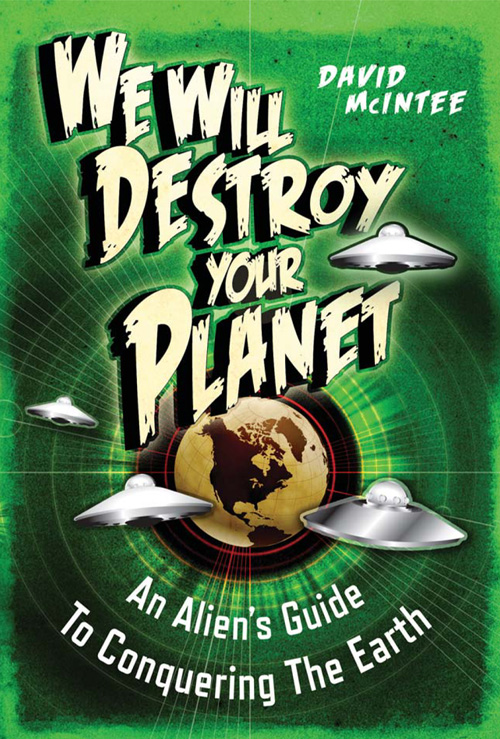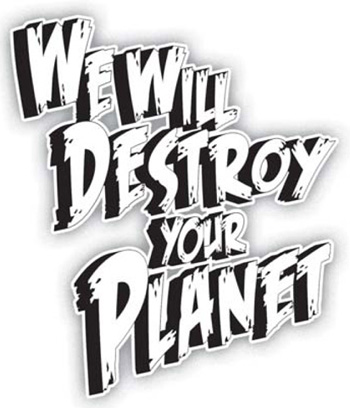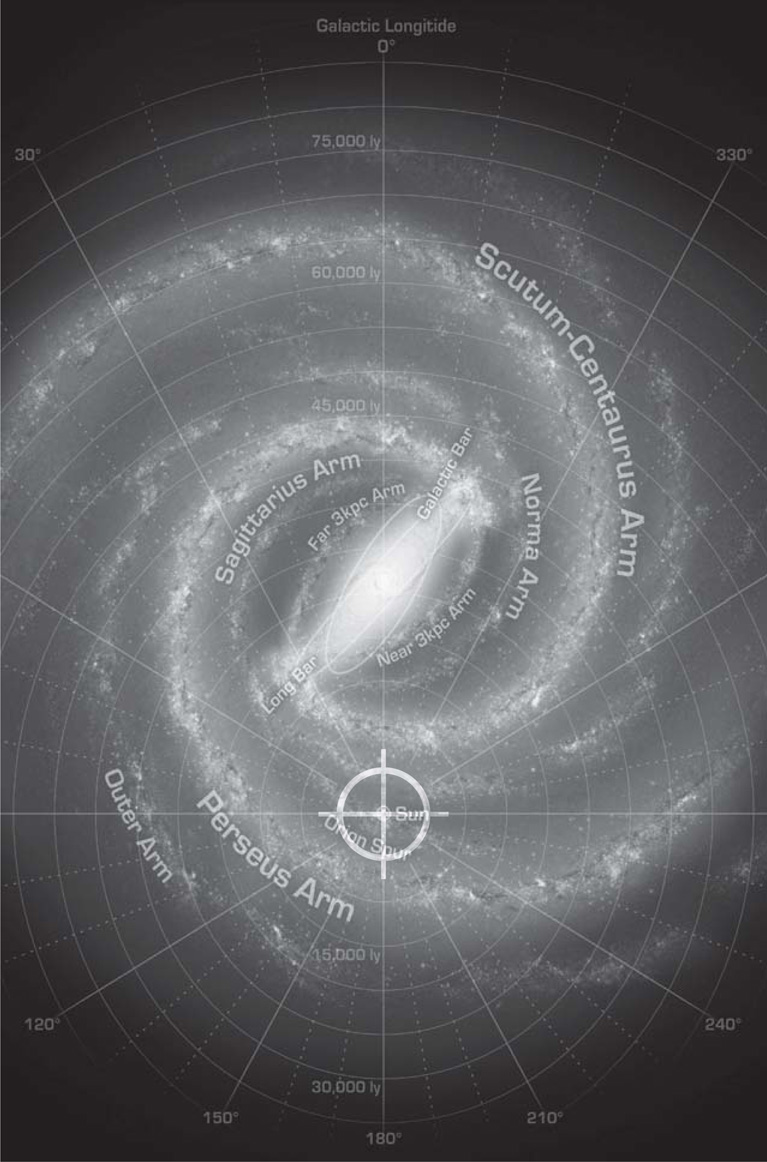We Will Destroy Your Planet
Read We Will Destroy Your Planet Online
Authors: David McIntee
Tags: #We will Destroy your Planet: An Alien’s Guide to Conquering the Earth


DAVID A McINTEE

An Alien's Guide to Conquering the Earth
Care and Feeding of Your Humans
No Battle Plan Survives First Contact with the Enemy

Thank you for choosing the planet Earth as your conquest target of choice. The local sentient population has long considered it to be a worthy destination for travellers from other planets, alternate dimensions, and future timelines.
The planet is of a medium size, replete with many thousands upon thousands of species of carbon-based life, and well stocked with liquid water, metallic deposits including iron and gold, and many other chemical and elemental resources.
Over time, records have amassed of many attempts by different species to invade, conquer, or destroy the Earth. Some have succeeded for a time, but most have failed. Partly this is due, according to the native humans, to their resistance being so strong and smart. More often it is because the invading forces have not properly thought through their plans and have taken foolish decisions based on whims. This can't be allowed to continue.
In this guide, you will learn most of the basics that you will need to know about efficiently and effectively conquering â or destroying â the Earth, dealing with its inhabitants, and making the best use of its position and resources, while at the same time denying these strategic resources to other powers within your sphere of influence in the universe.
With this knowledge, you will know your errors and how to avoid them. With this knowledge, there will be no defeats!
Other planets are, of course, available.
LOCATION
Earth is one of the planets belonging to the star known as Sol, which the planet's natives usually refer to simply as âthe Sun'. This Solar system is located about 14 light years above the equatorial symmetry plane, and orbits the centre of the Milky Way galaxy at a distance of about 27,000 light years (a journey that takes a quarter of a billion years to complete one orbit), at a speed of around 140 miles per second. The Solar system is currently in the Orion Spur against the Perseus arm.
The Solar system itself is, locally, generally considered to consist of nine planets, although the outermost, Pluto, has recently been downgraded to the status of âdwarf planet', leaving an official total of eight. There are also thought to be around 180 moons in the system, of which 19 have sufficiently stable orbits and sufficient mass to be considered dwarf planets if they were orbiting the Sun on their own, rather than around a parent planet.
To be sure you have the right system, you can compare distances to other star systems. The Sun is 4.24 light years from Proxima Centauri (and almost directly above it at that distance), 5.93 light years from Barnard's Star, 8.58 light years from the binary star system Sirius, and 10.92 light years from Ross 128, which is pretty much on the same equatorial plane as the Solar system.
The Earth itself is the third planet out from the Sun. The planet travels in an elliptical orbit at 67,000 miles per hour that takes it from a closest approach of 91.94 million miles to a maximum distance of 95 million miles. The mean distance is generally considered to be 93 million miles, or about eight light minutes. In other words it takes the light from the Sun eight minutes to reach the Earth. The Earth's orbit is tilted, compared to the Sun's equator, by 7.11 degrees.
The Earth should be simple enough to distinguish from the other solid (i.e. not gas giants, of which there are four) planets in the system, as it is the largest, densest, and fastest rotating of the rocky planets. It also has the highest gravity and strongest magnetic field of the solid planets.
Before arriving, it would be wise to familiarize yourself with the basic data on the planet, as well as making the requisite military intelligence and assessment surveys.
Like all rotating bodies formed under their own gravity, the Earth is not a true sphere. Rather it is an oblate spheroid with an equatorial diameter of 7,972.6 miles, a pole-to-pole diameter of 7,932 miles, and an equatorial circumference of 25,046.88 miles.
Its mass is currently around 5,877,681,383,000,000,000,000 Imperial tons, though it acquires anything up to 1,000 tons a day from meteors and the accretion of particles in space. Normally the amount of extra mass so gathered, however, is just a few tens of tons. If the Earth was able to gather sufficient extra mass it would move slightly closer to the Sun; however, even if the planet accreted the maximum 1,000 tons a day for a million years, it would still have increased in mass by 0.00000000001%, and would only move out of its current orbit and closer to the Sun by the same 0.00000000001%. There is, therefore, no cause for concern about the accretion gained between your initial survey and your actual arrival. The planet's orbit will not have moved, unless another advanced species has caused such a move by technological means.
There is one primary natural moon, generally referred to by the Earth's inhabitants simply as the Moon, or, sometimes, Luna. Of all the natural moons in the Solar system, this moon is the largest in relation to its parent body, and is the fifth largest moon in the system overall. It is also the second densest moon in the system, after Io, a moon of the system's largest gas giant planet, Jupiter.
The Moon's diameter is 27% of the radius of the Earth, and it has 60% of the density. It has no atmosphere, but has a stable surface, which can be landed and built upon. Curiously, due to their relative sizes and positions, the Sun and Moon appear the same size when viewed from Earth. This will not last forever, though, as the Moon's orbit is in fact retreating from the Earth very gradually, at a rate of about an inch and a half per year, according to laser rangefinding using mirrors left on the Lunar surface by visiting astronauts.
The Moon's orbit around the Earth is synchronous with the Earth's rotation period, and so always presents the same hemisphere to the parent planet. The hemisphere facing away from the planet is more heavily cratered from ancient comet and asteroid impacts, but may also harbour water ice. The concealed position and potential availability of water on the far side of the Moon make it a sensible choice for a staging area or observation base, which can remain hidden from the Earth.
Be aware, however, that the Earth's dominant life form, humanity, has the capacity to leave the homeworld and travel to the Moon, and several expeditions have done so, as have many automated probes. Remaining undetected in Lunar orbit, or on the surface, is therefore not guaranteed.
There are no other known true natural moons orbiting the Earth, although there are some smaller bodies which orbit the Sun at the same distance as the Earth, and which spend part of their orbit around the Earth. These include the asteroidal body called 3753 Cruithne, which some terrestrial natives consider to be Earth's second moon, though it does not truly orbit the Earth, but instead orbits the sun in a 1:1 orbital resonance with the Earth.
The number of artificial satellites placed in orbit by humanity varies. At the time of writing there are around three thousand, actually down from an operational peak of eight thousand in 2001. This number is obviously far below the number of pieces of debris from completed space missions that remain in orbit.
The total land surface area of the Earth is 93,087,500 square miles, which is actually just over 29% of the total surface area of the globe. The remaining 71% â all 225,707,500 square miles â is water, in the form of oceans, seas, rivers, lakes, and ice sheet. There is plenty of room for colonies or occupation forces, as the dominant life form, humanity, lives only on the land areas and, despite a population of eight billion or so, still leaves the vast majority of the land surface unoccupied, by being concentrated into urban centres which are easily visible from orbit due to their light pollution.
Continuing with physical data, however, the planetary volume is 0.677x632.2 cubic miles, and its density is 0.288lbs per cubic inch. Surface gravity, though, usually referred to by the natives as â1G', is actually 0.997G at the equator, which equates to a falling acceleration of 32 fps
2
. The planetary escape velocity, for when you want to leave, is 23,500mph.
The Earth rotates at 1,040mph, resulting in a terrestrial day of 23 hours, 56 minutes and 4.1 seconds. These divisions are based upon the amount of arc of sky travelled by the Sun, subdivided. The native humans round this period up to 24 hours, with periodic adjustments. Likewise, the terrestrial year â the period taken for the Earth to complete an orbit of the Sun, is 365.25 days, usually rounded down to 365 days, with an extra day added every fourth year.
The Earth's atmosphere is 78.08% nitrogen, 20.95% oxygen, 0.93% argon, and 0.039% carbon dioxide, with an average pressure of 101.325 kilopascals â or âone atmosphere', as the somewhat parochial natives unimaginatively term it â at the mean sea level. On average, about 1% of the total atmosphere is bound in the form of water vapour â clouds â at any given time.
The planetary structure is relatively rich in potentially useful elements and compounds, though not uniquely so in the Solar system.
The largest element of the planet's physical composition is iron, which makes up over 32% of its mass. Oxygen (30%), silicon (15%), and magnesium (13.9%) are the next most common elements. Because metallic elements are denser and more massive than the others, the Earth has developed as a series of layers, with the heavier elements at the centre. This means that it has essentially ended up as a crust of lighter elements sheathed around a core of iron, which also is blended with nickel and sulphur.
In fact, almost 90% of the core is iron, with just under 6% nickel, then sulphur, then traces of other elements. The crust, on the other hand, is 47% oxygen, as many of the materials making up the rocky crust are in fact oxides, in which an oxygen atom (usually one, but sometimes more) is bound to the structure of another element.
Silicon dioxide is the most common material containing oxygen atoms, and makes up some 60% of the continental structures, and 48% of the ocean floor.
As you can see from the details of the Earth's composition, there are plenty of important and useful materials both on, and within the makeup of, the planet.
Metallic elements are fairly obvious. The Earth is, obviously, especially rich in iron. It also contains a good supply of gold, an important material in space travel, even by humanity's limited standards, due to its insulation properties and non-corrodibility.
Aside from actual elements, there are many chemical compounds that have been formed by the heat and pressures of the Earth's formation and by circumstances since then. Liquid water is generally considered (by the native population at least) to be probably the most important, as all life on the planet depends upon it in some way or another.
